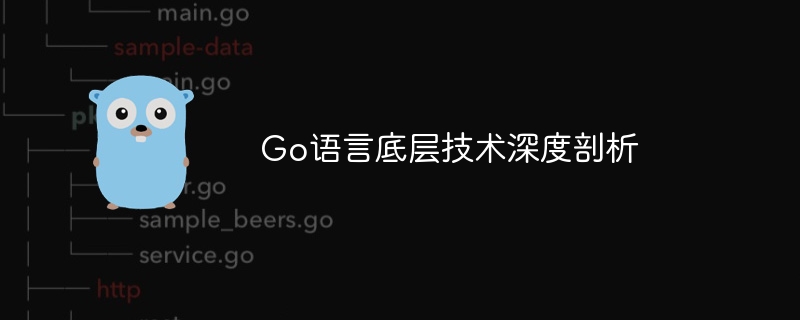Home >Backend Development >Golang >In-depth analysis of the underlying technology of Go language
In-depth analysis of the underlying technology of Go language
- WBOYWBOYWBOYWBOYWBOYWBOYWBOYWBOYWBOYWBOYWBOYWBOYWBOriginal
- 2024-03-14 09:15:04432browse

Title: In-depth analysis of the underlying technology of Go language
As a rapidly developing modern programming language, Go language has attracted widespread attention for its simplicity, efficiency and concurrency features. . However, many developers still have certain limitations on the underlying technology of the Go language. This article will provide an in-depth analysis of the underlying technology of the Go language and combine it with specific code examples to help readers better understand the underlying principles and features of the Go language.
1. Overview of the underlying technology of Go language
Go language is a static, object-oriented programming language developed by Google and open source. Its design goals are simplicity, efficiency, and concurrency. The underlying technology of Go language includes components such as compiler, runtime system and standard library. By in-depth understanding of these technologies, you can better understand and master the working principle of Go language.
- Compiler: The compiler of the Go language adopts a bottom-up compilation model. By converting the source code into an abstract syntax tree (AST) and performing lexical and syntactic analysis, it finally generates the target platform. machine code. The working process of the compiler includes stages such as lexical analysis, syntax analysis, type checking, code optimization and code generation. Based on an in-depth understanding of how the compiler works, you can better perform performance optimization and code debugging.
- Runtime system: The runtime system of the Go language is responsible for managing tasks such as memory allocation, garbage collection, and coroutine scheduling. In the Go language, each goroutine is a lightweight thread, scheduled and executed by the runtime system. A deep understanding of how runtime systems work is critical to writing efficient concurrent code.
- Standard library: Go language has a rich built-in standard library, including packages for input and output, network communication, data structure processing and other functions. An in-depth understanding of the underlying implementation of the standard library can help developers better understand its working principles and conduct customized development according to needs.
2. Examples of the underlying technology of the Go language
The following introduces the implementation principles of the underlying technology of the Go language through specific code examples:
- Compiler example :
package main
import "fmt"
func main() {
fmt.Println("Hello, World!")
}The above code is a simple Go language program, compiled and run through the following command:
go build -o hello hello.go ./hello
The compiler compiles the source code hello.go into the binary file hello, and Output "Hello, World!".
- Runtime system example:
package main
import (
"fmt"
"time"
)
func sayHello() {
for i := 0; i < 3; i++ {
fmt.Println("Hello, Go!")
time.Sleep(time.Second)
}
}
func main() {
go sayHello()
time.Sleep(3 * time.Second)
}The above code defines a goroutine, starts it in the main function and waits for its execution. Concurrent execution can be achieved through the scheduling of the runtime system.
- Standard library example:
package main
import (
"fmt"
"sort"
)
func main() {
nums := []int{3, 1, 4, 1, 5, 9, 2, 6, 5, 3}
sort.Ints(nums)
fmt.Println("Sorted nums:", nums)
}The above code uses the sort package in the standard library to sort an integer slice and output the sorted result.
Through the above examples, readers can have an in-depth understanding of the implementation principles of the underlying technology of the Go language, including compilers, runtime systems, and standard libraries. Through continuous learning and practice, readers can better master the underlying technology of the Go language and use it flexibly in actual development.
The above is the detailed content of In-depth analysis of the underlying technology of Go language. For more information, please follow other related articles on the PHP Chinese website!

